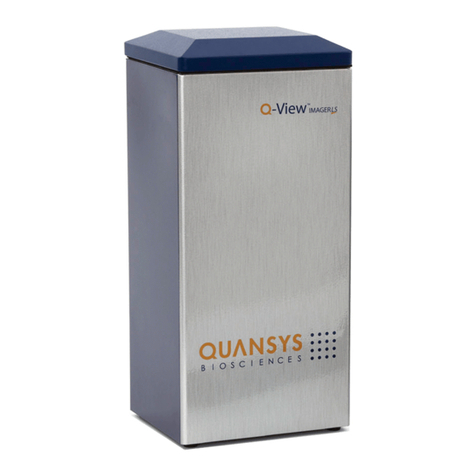
4
Q-View Imager Pro
device to pass ambient air across the camera to assist
in cooling. If the lab temperature is too high, the
camera may be unable to maintain 0° C. Recommended
operating conditions are 15–35° C. Humidity can also
cause operation problems for the Q-View Imager Pro.
Ensure your laboratory environment does not exceed
a dew point of 20° C to prevent condensation.
Ventilation and Dust
The fan on the bottom of the device pulls ambient air
across the camera to keep it cool. Ensure the room
where the Q-View Imager Pro is placed has adequate
ventilation to ensure cooling can occur. Dust in high
levels can be pulled into the fan and adhere to the
camera cooling apparatus. Dust can also collect on the
glass on the tray deck and cause dust particles to be
visible in your image. Please take precautions to keep
the lab bench surface and oors clean of dust. It is
important to keep any objects, such as paper or other
at materials, away from the bottom of the Q-View
Imager Pro as these can block airow to the fan.
Space
The footprint of the Q-View Imager Pro is 26.7 W x
24.1 D x 45.7 H cm (10.5 x 9.5 x 18 inches). Ensure
the space around the Q-View Imager Pro is free of
chemicals that can spill or other equipment that can
fall and damage the Q-View Imager Pro.
Vibration
The exposure times of the Q-View Imager Pro can be
up to 5 minutes. It’s important that the location of the
Q-View Imager Pro is free of excessive vibration. Make
sure equipment that might cause vibrations such as
vortex mixers, shakers, centrifuges, etc. are not co-
located on the bench with the Q-View Imager Pro.
Also consider where the Q-View Imager Pro is placed
in the laboratory. For example, the Q-View Imager
Pro should not be placed on a bench near a door that
could be slammed or on a bench near a desk where
someone could bump it during exposures.
Note: Q-View
Software prevents
imaging when the
target temperature
cannot be reached
and turns off cooling
to protect the camera.




























